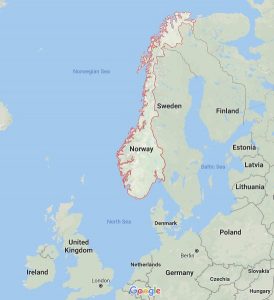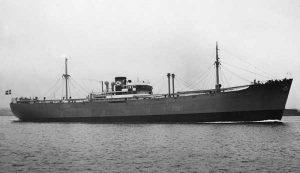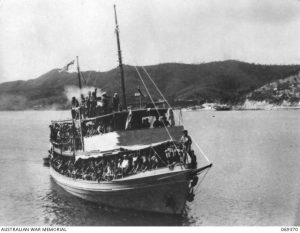- Author
- Editorial Staff
- Subjects
- Ship histories and stories, History - WW2
- Tags
-
- RAN Ships
- None noted.
- Publication
- March 2019 edition of the Naval Historical Review (all rights reserved)
What if anything what does Norway, at the far end of the northern hemisphere, have to do with the wartime security of Australia? As this story unfolds the answer is, quite a lot.
Norway is a mountainous country (about the same area as the British Isles and Ireland) much of it inhospitable and covered in snow and ice. There is an extensive coastline stretching from the North Sea near the entrance to the Baltic to the Barents Sea in the Arctic. As a result of its many fjords and inlets it comprises the world’s second largest coastline, only surpassed by Canada, with Australia coming in at seventh place. The population is relatively small and at the outbreak of WWII was about three million.
Until the discovery of offshore oil in the 1960s Norway had few natural resources and turned to the sea for employment and the generation of income. In the Depression of the 1930s Norwegian ship-owners took innovative risks in replacing their merchant fleet with new tonnage. They looked to the future, investing in diesel powered vessels, with an emphasis on oil tankers. At the outbreak of WWII their fleet ranked fourth in the world behind Great Britain, the United States and Japan. Most importantly this fleet comprised 18% of world tanker tonnage in new hulls.
Commencing on 9 April 1940 the German occupation of Denmark and Norway was swift. In Denmark resistance was seen as useless and the occupation was completed in a matter of hours. The Norwegians were surprised by the German advance on their country as they had remained neutral during WWI. While ill-prepared they resisted and this was bolstered by support from British, French and Polish forces. This proved ineffective. King Haakon VII and the Royal family, together with a nucleus of senior government officials, were evacuated to Britain in the cruiser HMS Devonshireon 7 June to establish a government-in-exile.
The evacuation, which also included British forces, did not pass without incident as only thirty miles from Devonshire the converted aircraft carrier HMS Glorious and destroyers HM Ships Acastaand Ardent,were sighted by the German battlecruiser KMS Scharnhorst.In the subsequent engagement all three Royal Naval ships were sunk with considerable loss of life. We might ponder the outcome if Scharnhorsthad also intercepted Devonshire,crammed with 460 of the most influential Norwegian citizens. Three days later, on 10 June, all resistance ended and the German occupation was completed with the installation of the pro-Nazi Prime Minister, Vidkun Quisling.
At the outbreak of war, the British government pressuredits neutral Norwegian counterpart to provide additional shipping for the Allied cause. In November 1939 Norway agreed to charter 150 tankers and other vessels to Britain. They paid a price for this bold initiative, as even before the invasion of Norway, 58 ships and 400 sailors had been lost to enemy action.
In April 1940 the Norwegian Shipping and Trade Mission (Nortraship) was established in London. With about 1,000 ships it controlled the largest shipping company in the world and made a major contribution to the Allied war effort. The eminent politician and Noble Peace Prize laureate, Philip Noel-Baker, expressed it thus:
The first great defeat of Hitler was the Battle of Britain. It was a turning point in history. If we had not had the Norwegian fleet of tankers on our side, we should not have had the aviation spirit to put our Hawker Hurricanes and our Spitfires into the sky. Without the Norwegian merchant fleet Britain and its allies would have lost the war.
Nortraship had its main offices in London’s Leadenhall Street, a vibrant hub of international commerce where the offices of major shipping companies congregated, and business could be done on a handshake. Another important outpost was opened in New York, with further representation in major seaports including Sydney, Melbourne, Adelaide, Brisbane, Fremantle, and Wellington in New Zealand.
The Norwegian merchant fleet supporting the Allies at the start of the war comprised about 1,000 vessels manned by 30,000 sailors. During five years of conflict 706 vessels were lost to enemy action and 3,670Norwegiansailorsdied,plusafurther977 foreign crew members helping to man Norwegian ships lost their lives.

MV Herstein
MV Herstein was typical of this modern fleet, a 5,100 gross ton freighter launched in 1939 by Burmeister and Wain of Copenhagen. She was 425 feet (129.5 m) in length with a beam of 56.7 feet (17.3 m). A 2-stroke, 8-cylinder B&W diesel engine gave a top speed of 14 knots. Under the command of Captain Gottfred Gundersen with a crew of 32 officers and men, she was owned by Sigurd Herlofsen and Company of Oslo. Of her crew, four came from Sweden (until 1905 Norway and Sweden were united) and one each from Australia, Estonia and the United States. It is assumed the latter joined to make good deficiencies caused by sickness or crew members jumping ship.
While details of her early voyages are imprecise we know that at the time Norway was occupied MV Herstein was in Hong Kong, and must have passed through Suez as we have another report of her in convoy east bound through Suez, arriving at Aden on 14 July 1940. She then reached the United States and departed New Orleans 1 October 1940 for passage via Panama to Auckland, Sydney and Melbourne. She was in Fremantle in November 1941 and was amongst ships searching for survivors from the sinking of HMAS Sydney,in what at that time was Australia’s worst maritime disaster. After searching in vain she sailed independently, reaching Sydney on 11 December.

Here Hersteinjoined convoy ZK5 with the 45,000-ton liner Aquitaniaand the 11,300-ton Sarpedon, taking onboard 4,250 troops and 10,000 tons of equipment for the defence of Port Moresby. They sailed on 28 December under the cruiser escort of HMA Ships Australia, Canberra, Perth and HMNZS Achilles.The convoy arrived safely on 4 January1942 and after unloading, Herstein
proceeded independently reaching Rabaul on 14 January to unload cargo from Sydney and Port Moresby. On 18 January she moved to a mooring and started loading a cargo of copra.
On 20 January after loading 2,000 tons of cargo, Rabaul was attacked by about 100 Japanese planes that bombed the town and its surrounds. Captain Gundersen was ashore visiting the ship’s agents when he saw his ship being attacked by three Val dive bombers that came down low to release their bombs. One exploded in the engine room resulting in a fire which the crew tried to extinguish, but this engulfed them and quickly spread through the ship. Her twin 0.303 anti-aircraft guns were in continuous use until a second bomb exploded knocking out the guns. When a third bomb exploded amidships the crew jumped overboard and swam ashore which they reached safely, except for one Swedish steward, Karl Thorsell, who was never seen again. Three injured survivors were admitted to hospital, another four received first aid for burns.
During the course of the night the mooring ropes burnt through and the ship drifted across the harbor and was still on fire the next morning. Owing to the ferocity of the fire fueled by the cargo of copra the ship became a total loss. During the afternoon news was received that the Japanese were preparing to land at Rabaul. Herstein’s crew was advised to get away from the town with others heading for the coast or into the mountains. Captain Gundersen was determined not to be captured and joined a group of Australians who proceeded overland, covering 300 miles in 78 days. During this ordeal half the party died but Gundersen and other survivors managed to reach a plantation at Jacquinot Bay where they were brought off by the PNG Governor’s yacht Laurabadacommanded by the bold Coastwatcher, newly commissioned LEUT Ivan Champion RANVR. They arrived at Port Moresby on 12 April and eventually reached Sydney on 26 April 1942.
The remainder of Herstein’screw remained at Rabaul, becoming prisoners of the Japanese. They later boarded the liner Montevideo Maruand with other Australian and British prisoners were bound for Japan. When off the west coast of the Philippines on 1 July 1942, they were torpedoed and sunk by the submarine USS Sturgeon SS-187. There were no survivors from the 1,050 Allied POWs. Included in their number was James Tynan, the young Australian mess boy who had so recently joined Herstein.This became Australia’s worst maritime disaster. After six years Captain Gundersen returned to his home in Norway in 1946.
Summary
The Norwegian contribution in ships and seafarers to the allied cause during the Second World War was proportionally greater than expected from a nation with such a relatively small population. But as a nation with ancient and proud seafaring traditions she was prepared to provide self-sacrifice in ships and men. Seventy percent of her vessels were sunk in enemy action and over fifteen percent of her seafarers gave their lives. All this was when their country was under occupation with no opportunity of seeing family and loved ones, and they stuck to their craft, demonstrating great fortitude and personal courage.

The story of one ship, MV Herstein, chartered by the Australian Government, gives an insight to this commitment. She started her war in the far distant Pacific and then, when sailing independently in waters where enemy raiders and submarines lurked, was called upon to search for survivors from Sydney, in what was thought to be our worst maritime disaster. Soon she was in convoy taking troops and equipment to New Guinea and, again in waters disputed by the enemy, proceeded without escort to meet her end in a remoteoutpostofNew Guinea.Withonesolitary exception her crew paid the ultimate sacrifice when they tragically died aboard the Montevideo Maru, ironically sunk by friend, not foe, in what was among our worst maritime disasters.
Australians must not forget their debt to the Norwegian Merchant Service and to its many brave men.




